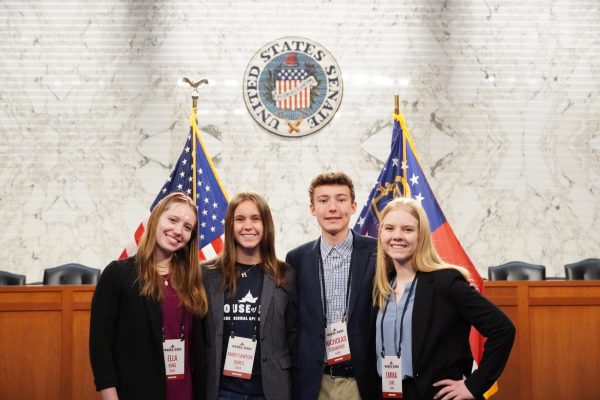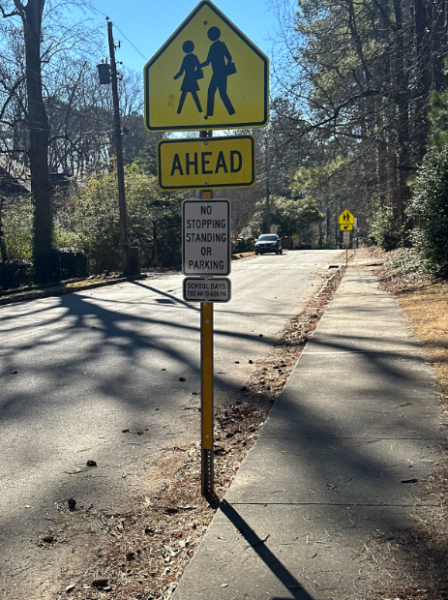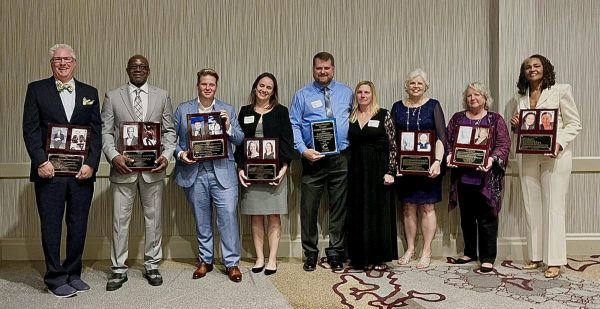One Year Later, Some Students Return to Classrooms
Freshmen enter the building March 9
Nearly a year after they left, DeKalb County students are returning to classrooms. If they choose to.On February 23, DeKalb County School District Superintendent Cheryl Watson-Harris gave a speech about the current state of DeKalb schools and announced a return date for students going back to optional in-person learning. For Chamblee Charter High School, freshmen can return to—or really visit for the first time—their classrooms and teachers on March 9. A week later on March 15, students in all other grades can return to the building.
CCHS posted a return to school survey last week in order to plan for those students. The survey closed on March 2, but results of the survey were not available as of March 3.
Students who selected no on the survey will continue to take their virtual classes and be unable to switch back to in-person learning until the start of the next grading period. Students who select yes on the survey will be able to return to partial in-person classes depending on their grade level and what cohort they are placed into.
“Note that you may select ‘Yes, my child will return’ and then tell us later that you have changed your mind,” said an administrator update on that survey. “We will accommodate siblings attending school on the same day but cannot accommodate other requests.”
The CCHS administration assumes that students who did not respond to the survey plan to return to in-person classes.
The following dates were published by the administration for when students can return.
- 3/9 and 3/11 – Grade 9 by cohorts
- Week of 3/15 – Grades 9-12 by cohort (2 days this week)
- Week of 3/22 – Grades 9-12 by cohort (2 days this week)
- Week of 3/29 – Grades 9-12 (4 days per week); Wednesdays are for tutorials
Initially, school officials announced students would begin returning to classrooms in September 2020 because the county’s metric for determining safety—the two-week average of COVID cases per 100,000 residents—had dropped below 100, the number set by school officials. However, that number quickly climbed well over 300 cases per 100,000 residents and those plans to return were canceled.
In December 2020, school officials changed the metric they were following to determine whether or not it was safe to return to in-person learning to the “positivity rate,” the percentage of COVID tests in the county that were positive. Based on that metric, officials announced plans to welcome students back in early January. However, the positivity rate increased from 10% to over 15% as the virus raged across the county and new variants appeared. Those return-to-school plans were also canceled, though staff was asked to return to empty classrooms.
According to the Georgia Department of Public Health, the positivity rate in DeKalb County was 6.4% as of March 1. The 14-day case rate in the county was 264 in the same report. Both indicators have been trending down over the last 30 days.
For students returning to CCHS, the building will not be open before 7:30 a.m. At that time, the gym and cafeteria will open—the cafeteria for those eating breakfast, the gym for all other students. Students who drive themselves or are dropped off by carpool are asked not to arrive until 8:05. All students are asked to be out of the building by 3:45. No club meetings will take place.
Inside the building, decals have been placed on hallway floors to indicate direction of travel through the halls and to remind students and staff to remain six feet apart when possible. Hand sanitizer stations have also been added in several locations.
Chamblee teachers, most of whom have been back in the building for nearly two months, are approaching this return to school cautiously but also acknowledge the excitement of returning to some type of normalcy.
“I teach Civics, World Geography, and AP European History. After surveying my classes it appears approximately 40% of my students have indicated plans to return,” said social studies teacher Gregory Valley. “I plan to continue receiving work in Google Classroom to provide everyone consistency and routine as we head into the final school quarter.”
Valley, who also coaches swim and dive, believes that DeKalb will benefit from having the chance to see what other districts have done.
“I coached swim and dive this winter and was able to hear from other coaches from across the state about their experiences in school,” he said. “DeKalb has taken a very careful and cautious approach to reopening and has had the benefit of learning best practices from other districts.”
For orchestra teacher Phillip Barnard the return to school means a chance to actually meet some of his students for the first time.
“I teach orchestra. Since it’s my first year here at Chamblee, I’m excited to start meeting students in person,” wrote Barnard in an email in late February. “But of course, I’m nervous (for all the obvious reasons) about being face to face. In informal polling of my orchestra classes, I’m expecting roughly 50% of orchestra students to return at the beginning of the face-to-face option.”
For a class that requires students to blow air through many instruments in the same room, Barnard is doing what he can to ensure everyone’s health.
“One of the biggest things I am doing in my classes to help keep students safe is using two large-scale air purifiers in the orchestra room,” he wrote. “I think splitting the students into smaller cohorts is a good idea. And giving the option of virtual to those who are not ready yet is also important.”
One teacher, who wished to remain anonymous, believes that students are returning too soon and wishes that DeKalb County would wait until more staff were vaccinated.
“I think it’s ill-timed. Because our governor has just recently said that teachers are on the list [to be vaccinated]. And it makes more sense to ensure that the teachers, the administrators, the custodial staff of our schools are protected before we bring students in. So I think our return to school is ill-timed,” said the teacher.
That said, the teacher also believes that Chamblee’s administration is doing a good job at the school level.
“I would say that Principal Barnes and her team of assistant principals are handling this with compassion, with grace, with kindness, and most importantly, common sense. I feel that that is something that is very lacking in county-wide leadership,” said the teacher. “This is an equity and equality issue that not every school can do the same things that we’re doing.”
The teacher also wants to make sure that students understand going back means continuing to do virtual learning, just from a desk in the classroom instead of at home.
“I want to be very candid with [my students] that the only difference between being in-person and being virtual or not in-person is where you sit,” said the teacher. “You’re either sitting with a computer in my classroom, or you’re sitting with a computer in your home. That’s how concurrent learning is going to work in my classroom until the herd immunity is basically reached.”
Some aspects of the school day will look and feel “normal” though. Students will eat their lunches in the cafeteria or on the sidewalk cafe if the weather allows. There will be four lunches instead of the usual three to allow for smaller groups of students to be in the cafeteria at the same time.
Other parts of school will serve as reminders that there is still a pandemic going on. Water fountains have been turned off and students are encouraged to bring their own water. Bathrooms will be closed between classes, and students will be allowed to use them during class periods in order to maintain records of who is going in and out in case contact tracing is needed. And there will be no lockers for students to use; students must carry whatever they need with them from class to class.
Some students, such as junior Phinn Adams (‘22), are not going back to school and believe the district should wait until more people have received COVID-19 vaccines.
“I’m not going back to school. I think that the school system is doing the best they can with a bad situation. But I don’t think that we should be going back to school,” said Adams. “I do think that they should wait longer before sending teachers and students back to school until more of the population is vaccinated.”
Other students, such as junior Ethan Santucci (‘22), are going back to in-person learning because their parents are making them.
“My parents are forcing me to go back and I don’t want to,” said Santucci. “My parents are concerned for my performance and they think that the risk of getting COVID is low enough to justify me going back.”
Santucci believes that more teachers and students should be vaccinated before moving from voluntary attendance to sending everyone back.
“I think we need to get all the teachers vaccinated and at least a good portion of the students before sending everyone back. Until then, I like their system of voluntary in-person attendance,” said Santucci.
While true that the county can look to other school systems and their reopening successes and setbacks, the return to school in the next few weeks will undoubtedly experience problems that will be worked out as they are encountered. But, for the first time in a year, schools will be open.
Your donation will support the student journalists of Chamblee High School Blue & Gold. Your contribution will allow us to print editions of our work and cover our annual website hosting costs. Currently, we are working to fund a Halloween satire edition.

Keegan Brooks is a senior at Chamblee and this is his third year with The Blue & Gold. In five years, he hopes to be a student or alumni of a college somewhere. Hopefully by then he will have also finished the shows that he started watching, but never finished. He can be contacted via email at [email protected] or on Twitter @KeeganATL.










